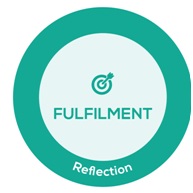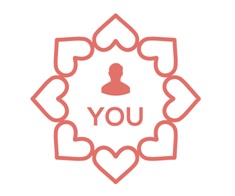A Coaching Model Created by Lucia Hargasova
(Conscious Leadership Coach, UNITED KINGDOM)

Introduction:
All transformation changes, but not all change is transformation. As Alice said in her Wonderland experience, “at least I know who I was when I got up this morning, but I think I must have been changed several times since then.”
What fascinates me personally is that there are morethan400 psychotherapies producing some elements of change, yet it is coaching which has been growing as one of the most successful ways of igniting change. Any activity that we initiate to help modify our thinking, feeling or behavior is a change process. The most widely used change process is consciousness-raising or what we call an increase in awareness. To make unconscious conscious using our brain.
I personally believe that one of the key reasons why coaching is so powerful in supporting positive change, transformation or raise of consciousness within individuals is that: On the part of the coach, we have an unconditional faith in the process and in the client’s intentions and abilities they have within them. Of course, it is also important that the client has absolute trust in the coach and the process, hence the coaching model can be a powerful tool in the whole experience, even if it is often ‘invisible’.

Presence

You cannot find yourself by going into the past. You can find yourself by coming into the present. (Eckhart Tolle, The Power of Now)
Holding space. The Watcher. The Awareness. Coaching is about increasing client awareness and that starts with the willingness to be able to witness our own life in a nonjudgmental way. We then use this learning to hold space and look at our client’s lives in a nonjudgmental way and with pure curiosity. Holding space means the ability to observe without judgment. It is not identifying anything is good or bad, not anything is right or wrong but simply witnessing everything in a very compassionate way.
Self-management ahead of the session, setting intention, mindfulness practice from the coaching side. From coach to client perspective, facilitating client presence, guiding them to arrive here and now. Their own wisdom is harder to access without quiet and still mind. That is where the magic happens.
Unique Intention
Energy flows where attention goes (Tony Robbins)
At this stage of any coaching conversation, it is important to establish what is the client’s intention for the session. We guide and support this journey through our pure presence. Coaching is beyond just an aimless chat. It is our responsibility to understand what is required in the specific coaching interaction. For a client at this stage, it could be a bigger picture vision, striving for clarity, or a specific goal. Initiating the discussion using an iterative clarification of the coachee’s needs, setting the goals in line with their desired outcome and agreeing on the ground rules not only for the session but also for the entire coaching journey.
Reality
Reality is merely an illusion, albeit a very persistent one. (Albert Einstein)
Who we are and what we do is influenced by the stories we tell ourselves and the ways in which we narrate those experiences have impacts on how we think and feel. (Triggers& Thoughts have a direct impact on our feelings). Questioning what is important about the client’s goal shapes the desire and leads to commitment and action in a completely different vibration compared to something which is a goal-driven by ego or social pressure. This is an opportunity to get deeper. An opportunity to question their/a belief system. This may be simple questions like “what is it about XYZ belief that makes it true“what’s working, what’s not working?” If we work at the level of underlying drivers, we are looking at the client’s personal style, orientation (introvert or extravert), culture, worldview, assumptions, values, beliefs, core needs and life experiences.

Purpose
If you have a strong purpose in life, you don’t have to be pushed. Your passion will drive you there. (Roy T. Bennett, The Light in the Heart)
This is where the intention becomes a very specific goal. This may be the same as original intention but after the client has had an opportunity to explore the importance of the goal, it becomes more specific, clearer, perhaps more aligned to their core values. This is about being the most authentic self, based on values that are guiding them in their decision making. At this stage, we consider talking about measuring the goal in a way that is important for the client. This may be a change in a way they feel or a specific time scale. Here it is important to remember not all goals are action orientated. Sometimes letting go, not doing anything, a shift in an emotional state is what is needed.
Options
We are our choices. (Jean-Paul Sartre)
Questions are one of the most powerful ways to manage the mind. The brain is set to want to answer questions and if we ask powerful questions we allow for openness and continue to raise consciousness. We challenge our clients to think through possibilities for future action in resolving a situation or achieving a goal. Here is our chance to help our clients get creative. Creativity leads to the possibility
Note: Asking the client what would happen, or what they would feel if they started doing the opposite of what they’ve been doing to reach this goal. If nothing else, it’s a creative exercise
Strategies
Action breeds confidence and courage. If you want to conquer fear, do not sit home and think about it. Go out and get busy. (Dale Carnegie)
Create a specific plan to get to the goal. These are the tangible steps to achieve the client’s goal. How would the client know when they have achieved it? This can be 1 change in their life, this can be several. The more tangible the client can make the goal, the more likely it is for the client to feel the potential as a reality. We can explore strengths that impact the actions, their structures, and resources in place
Expectations
I’m not in this world to live up to your expectations and you’re not in this world to live up to mine. (Bruce Lee)
Step back and allow them to review if this is what they can do and what they want. How does it feel? What could stand in their way? Are they being too hard on themselves?

Reflection
Success without fulfillment is the ultimate failure. (Tony Robbins)
Reflection has been described as a process that helps turn the experience into knowledge. It allows people to clarify their thoughts and feelings, thereby gaining valuable self-knowledge. Here is the opportunity to reflect on learnings from the individual sessions as well as the client’s goals, achievements or setbacks. What worked what did not? What did the client learn? Checking in if they feel fulfilled (has anything shifted, changed, has the goal been achieved.) It requires the client to give a thoughtful and emotional reappraisal of their problem and an assessment of the kind of person they maybe once they have conquered it. It enables the client to see that life would be significantly better without the problem. What are their examples to plan or celebrate their success?

You:
Always be a first-rate version of yourself and not a second rate version of someone else. (Judy Garland)
This is at the heart of the “Purposeful You” coaching model. It is about honoring the client’s own truth and their potential moving to their authentic Self. The coach helps the client to achieve their personal best and to produce the results they want in their personal and professional lives. Coaching ensures the client can give their best, learn and develop in the way they wish. The coach need not be an expert in their clients’ field of work. To empower the client that they are the healer of their problems and challenges, and they have all the resources within to come up with the solution or solutions. To continue to grow their own Emotional, Spiritual, Intellectual Intelligence.
Conclusion:
Personally, it took me a while to fully understand the power behind using a coaching model. I do appreciate how ICA inspires the possibility to stay authentic in our own way we offer our knowledge, experience, and expertise to guide clients in their journey. And that is from very early on. Developing this coaching model helped me to understand the coaching relationship from a system perspective and the value of having a structure behind interactions. That alone allows for flexibility and intuition. And for that I am grateful.